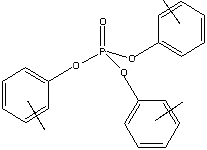| TRICRESYL PHOSPHATE | ||
|
PRODUCT IDENTIFICATION |
||
| CAS NO |
1330-78-5 (Mixture) 78-30-8 (Tri-o-cresyl phosphate) 563-04-2 (Tri-m-cresyl phosphate) 78-32-0 (Tri-p-cresyl phosphate) |
|
| EINECS NO. | 215-548-8 | |
| FORMULA | (CH3C6H40)3PO | |
| MOL WT. | 368.37 | |
| H.S. CODE | ||
|
TOXICITY |
Oral rat LD50: 300 mg/kg | |
| SYNONYMS | TCP; Tritolyl phosphate; | |
| Phosphoric acid tritolyl ester; Cresyl phosphate; Tris(methylphenyl)ester of phosphoric acid; Phosphoric acid tris(methylphenyl) ester; Tricresyl phosphates; Tritolyl phosphate; Tricresyl phosphate; Phosphoric acid tolyl ester; Thiorthocresyl phosphate; Tris(tolyloxy)phosphine oxide; Plasticizer TCP; Tritolylfosfat; Tricresilfosfati; Phosphate de tricresyle; EPA Pesticide Chemical Code 083401; Kronitex; Lindol; Other RN: 25013-17-6; 34902-62-0; 56499-45-7; 56573-10-5; 69234-04-4; 73299-28-2; | ||
| SMILES | P(Oc1ccccc1)(Oc1ccccc1)(Oc1ccccc1)=O.C*.C*.C* | |
|
CLASSIFICATION |
|
|
|
PHYSICAL AND CHEMICAL PROPERTIES |
||
| PHYSICAL STATE | clear to pale yellow oily liquid |
|
| MELTING POINT | < -40C | |
| BOILING POINT | 240 - 255 C at 10 mmHg |
|
| SPECIFIC GRAVITY | 1.143 | |
| SOLUBILITY IN WATER | Insoluble (0.36 mg/l) | |
|
SOLVENT SOLUBILITY |
|
|
| pH |
|
|
| VAPOR DENSITY | 12.7 | |
| log Pow | 5.11 (Octanol-water) | |
| VAPOR PRESSURE | (mmHg) | |
| HENRY'S LAW | 8.08E-07 (atm-m3/mole at 25 C) | |
| OH RATE | 1.44E-11 (cm3/molecule-sec at 25 C Atmospheric) | |
| NFPA RATINGS | Health: 2; Flammability: 1; Reactivity: 0 | |
|
REFRACTIVE INDEX |
1.555 |
|
| FLASH POINT | > 225 C | |
| STABILITY | Stable under ordinary conditions | |
|
GENERAL DESCRIPTION & APPLICATIONS |
||
|
Tricresyl phosphate (TCP) is a non-flammable, viscous clear liquid;
insoluble in water, It is stable in neutral and acidic media at normal
temperatures. But it is readily hydrolysed in an alkaline medium, producing
dicresyl phosphate and cresol. Commercial TCP is the mixture of isomers (ortho-,
meta-, and para-isomers). TCP is produced by the reaction of cresols (or
cresylic acid) with phosphorus oxychloride. Tricresyl phosphate is used;
Esters of phosphoric acid (called organophosphates) are used in industrial applications as flame-retardants and plasticizers (affording some flame retardancy) in plastics, rubbers and varnishes. Organophosphates are the most commonly used flame-retardants in that group. Hydraulic fluids and lubricants also contain organophosphates such as tricresyl phosphates, triaryl or trialkyl phosphates to enhance their properties in use. Organophosphates are used as defoamers in antifreze solutions, in pulp and paper production and for oil field drilling needs. They can be used as antifoam agents in detergent solutions, and in various emulsions, paints, and adhesives. Some alkyl phosphates are used as adhesive promoters and for corrosion protection in coatings. Phosphoric acid alkyl esters produced generally by the reaction of either alcohols, alcohol ethoxylates or phenyl ethoxylates with polyphosphoric acid or phosphorous pentoxide are anionic surfactants which have the main feature of the stability in alkaline conditions over other surfactants. They have a wide range of properties including outstanding wetting, emulsification, lubrication, coupling activity and detergency. They exhibit the properties of anti-wear and corrosion inhibition either as free esters or in the forms of metal and amine salts. They are also used as alkylation agent for nitrogen heterocyclic compounds and as catalysts to produce phenolic and urea resins. They are used as solvents in liquid-liquid extractants or separation agent of metals. They are is used as heat exchange media and as pigment grinding assistants and antifoam agents. Synthetic high-temperature lubricating oil consisting of tri-o-cresyl phosphate 2%, tri-m-cresyl phosphate 42%, tri-p-cresyl phosphate 31%, tris(dimethylphenyl) phosphates 18%, tris(ethylphenyl) phosphate 6%, other triaryl phosphates 1%. |
||
| SALES SPECIFICATION | ||
|
APPEARANCE |
clear to pale yellow oily liquid |
|
|
ACID NUMBER |
0.1 max (mg KOH/kg) |
|
| DENSITY |
1.185 ± 0.01 |
|
| COLOR, HAZEN | 350max | |
| TRANSPORTATION | ||
| PACKING |
220kgs in drum |
|
| HAZARD CLASS |
6.1 (Packing Group: II) |
|
| UN NO. | 2574 | |
| OTHER INFORMATION | ||
| Hazard Symbols: XN N, Risk Phrases: 21/22-51/53, Safety Phrases: 28-61 | ||
